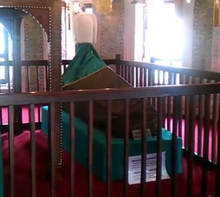Şehzade Cihangir
| Şehzade Cihangir | |
|---|---|
 The tomb of Şehzade Cihangir inside Şehzade Mosque | |
| Born | 1531 Old Palace, Constantinople, Ottoman Empire (present day Istanbul, Turkey) |
| Died | 27 November 1553 (aged 21–22) Aleppo, Ottoman Empire |
| Burial | Şehzade Mosque, Istanbul |
| Dynasty | Ottoman |
| Father | Suleiman the Magnificent |
| Mother | Hurrem Sultan |
| Religion | Sunni Islam |
Şehzade Cihangir (Ottoman Turkish: شهزاده جهانکير; 1531 – 27 November 1553) was an Ottoman prince, the sixth and youngest child of Sultan Suleiman the Magnificent and his wife Hurrem Sultan.
Life[]
Cihangir was born in Constantinople in 1531[1][2] during the reign of his father, Suleiman the Magnificent. His mother was Hurrem Sultan,[1][2] an Orthodox priest's daughter,[3] who was the current Sultan's concubine at the time. In 1533 or 1534, his mother, Hurrem, was freed and became Suleiman's legal wife.[4] He had four elder brothers, Şehzade Mehmed, Şehzade Abdullah, who died at the age of three years, Şehzade Selim (future Selim II), and Şehzade Bayezid, and an elder sister Mihrimah Sultan.[1][2] He was educated together with his older brothers under supervision of his time. He wrote poems with the pen name Zarifi, and was also interested in calligraphy.[5]
In 1539, Cihangir and his elder brother Bayezid were circumcised, and their sister Mihrimah was married to Rüstem Pasha. The collective festivities lasted fifteen days.[6] In March 1547 Cihangir and his mother travelled to Manisa, visiting his elder Selim, who had been transferred there after Mehmed's death in 1543, and spent a month there.[7] In 1548, he accompanied his father to the second Iran expedition.[5]
Cihangir had health problems, and was a hunchback.[1] He did not receive a provincial governorate because his infirmity was seen as a disqualification for rulership and perhaps also because of his need for medical treatment. In one of her letters to the sultan while he was on military campaign, his mother wrote of the success of an operation performed on the child's shoulder.[7] As the youngest child in the family and as a result of his disability, Cihangir was loved and treated exclusively.[8]
Cihangir was his father's constant companion.[9] His father had acknowledged the probability of his elder half-brother Şehzade Mustafa's success. However, Cihangir ventured that his physical deformity would allow him to escape the princely fate of fratricide, to which his father responded, "My son, Mustafa will become the sultan and will deprive you all of your lives."[10]
Death[]
In the third Iran expedition, Cihangir together with his father departed from Istanbul and reached the plains of Ereğli. Şehzade Mustafa, also arrived with his troops from Konya, where he was strangled by their father's guards on 6 October 1553. Cihangir was shocked by the situation since he was particularly fond of his half-brother Mustafa, and the army was demoralized when they heard about the event. His melancholy was understood as they arrived in Aleppo, and this frail young man could not tolerate this unbearable situation and the difficult journey. He finally died in Aleppo[5] on 27 November 1553.[11][12][13] He could not recover from the shock and grief caused by his brother's execution.[11] One source says that he committed suicide on hearing the news.[14]
After his death, his body was taken to Istanbul where he was buried alongside his older brother Şehzade Mehmed in the Şehzade Mosque.[5] The Istanbul neighborhood of Cihangir was named after Şehzade Cihangir when his father had Mimar Sinan build a wooden mosque there in 1559 to commemorate his death.[15] The area, which overlooks the Bosphorous, was one of Cihangir's favorite places. The neighborhood's name comes from this mosque.[5]
In popular culture[]
- In the television series Muhteşem Yüzyıl, Cihangir is played by Turkish actor Tolga Sarıtaş.[16][17]
References[]
- ^ Jump up to: a b c d Peirce 1993, p. 60.
- ^ Jump up to: a b c Yermolenko 2005, p. 233.
- ^ Yermolenko 2005, p. 234.
- ^ Yermolenko 2005, p. 235.
- ^ Jump up to: a b c d e Turgut, Turgut & Turgut 2015, p. 765.
- ^ Peirce 1993, p. 68, 76, 123.
- ^ Jump up to: a b Peirce 1993, p. 61.
- ^ Turgut, Turgut & Turgut 2015, p. 767.
- ^ Peirce 1993, p. 87.
- ^ Peirce 1993, p. 81.
- ^ Jump up to: a b Esin Atl; Esin Atıl; Arifi (1986). Süleymanname: The Illustrated History of Süleyman the Magnificent. National Gallery of Art. p. 221. ISBN 978-0-89468-088-5.
- ^ ATA-USA: Bulletin of the Assembly of Turkish American Associations. The Association. 1986. p. 36.
- ^ John Freely (1999). Inside the Seraglio: Private Lives of the Sultans in Istanbul. Viking. p. 62. ISBN 978-0-670-87839-0.
- ^ J. M. Rogers; John Michael Rogers; R. M. Ward (1988). Süleyman the Magnificent. British Museum Publications. p. 21. ISBN 978-0-7141-1440-8.
- ^ Hafiz Hueseyin Ayvansaray-i; David J. Roxburgh (2000). The Garden of the Mosques: Hafiz Hüseyin Al-Ayvansarayî's Guide to the Muslim Monuments of Ottoman Istanbul. Brill. p. 18. ISBN 978-90-04-11242-1.
- ^ "Muhteşem Yüzyıl-Tolga Sarıtaş/ Şehzade Cihangir'in acısı ekrandan taştı!/TV Programları/milliyet blog". blog.milliyet.com.tr. Retrieved 2017-10-12.
- ^ Magnificent Century (TV Series 2011–2014), retrieved 2017-10-12
Sources[]
- Leslie Peirce (1993). Imperial Harem: Women and Sovereignty in the Ottoman Empire. Oxford University Press. ISBN 0-19-508677-5.
- Yermolenko, Galina (April 2005). "Roxolana: "The Greatest Empresse of the East". DeSales University, Center Valley, Pennsylvania. Cite journal requires
|journal=(help) - Turgut, Ali Ç.; Turgut, Yaşar B.; Turgut, Mehmet (2015-11-21). "Neurological disease of Şehzade Cihangir in the Ottoman history: spinal dysraphism". Child's Nervous System. Springer Science and Business Media LLC. 32 (5): 765–767. doi:10.1007/s00381-015-2965-2. ISSN 0256-7040.
- 1531 births
- 1553 deaths
- Turkish poets
- 16th-century people of the Ottoman Empire
- People of the Ottoman Empire of Ukrainian descent
- 16th-century Ottoman royalty
- Sons of Ottoman sultans
- People from Istanbul
- Turks of the Ottoman Empire
- Suleiman the Magnificent
- Royalty and nobility with disabilities
